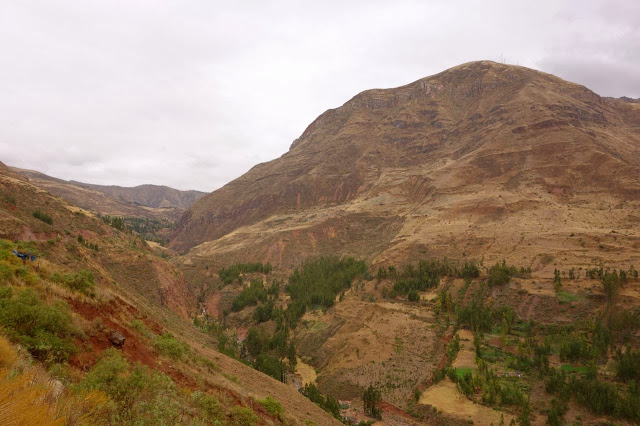The Sacred Valley, or Urubamba valley, is between Cusco and Machu Pichu. Without knowing it ahead, it was a perfect day to progressively discover the Andes, home to the Inca cultures, and few Incas sites, before to reach MP.
We started with few stops during the first 2 hours drive to discover the Andes mountains scenery surrounding us. We are around 3,000m high, and valleys & peaks seem to be between 2,000 and 5,000m high, this is impressive. Mountains are steep, with a mix of green and orange-rocky colors, sometimes cut by the old terraces incas had set-up all around to grow their crops.
 |
| Sacred valley view 1 |
 |
| Sacred valley view 2 |
After a couple of hours, we reach the small village of Taray, where G-Adventure has a partnership to support the local community, which is supposed to show us how they live and weave then knit the Peruvians textiles & clothes you can find everywhere on the markets. I wasn't particularly thrilled to this idea, as I was clearly thinking this as a touristic trap with people half "forced" to behave for tourists but just willing to sell their work and begging for money.
However, it proved to be really good, with a lovely group of women with their children, who looked to really worked as best as they could, and were happy to receive visitors, who they knew "support" them via the trip tour we have paid. So even without any purchases, they are already happy that we come.
Net, we spent a really good time discovering how they were taking the alpaca wool to tint them, weave them, then knit them for various clothes & accessories.
I could also find an alpaca scarf (at such a cheap price, and I did not really dare negotiating much!) which proved to be super useful for the cold Peruvian & Bolivian weather :-).
 |
| Welcoming in the center of the work place, with raw wool beams |
 |
| Children stay with their mother while they work |
 |
| Raw alpaca wool |
 |
| (very!) traditional weaving! |
 |
| Traditional knitting |
 |
| Couldn't resist to a touristic but friendly picture! |
KALLAQASA
3rd stop of the day around Pissac, Kallaqasa will also be my first "real" inca ruins discovery. Featuring the "classics" incas terraces on steep hillsides, topped up by ruins of houses and temples, the set-up of the site is immediately impressive, and start to make me estimate how the Inca civilization had really been developed and advanced. Hiking up to the village on the terraces side enable to see how various parts of the site were organized, from the agricultural terraces, temples, houses... wow!
This "starter" definitively excites my curiosity for the rest of the day and Machu Pichu!
 |
| View on the terraces from the top of the village |
 |
| Valley view from the village top |
 |
| Houses & temple on top of the mountain peak |
 |
| View of the terraces and village from the bottom |
 |
| View of the valley, terraces and a bit the village |
Driving a good part of the afternoon to reach our last stop, we arrive there end afternoon and need to rush in order to visit with still some sun!
Ollantaytambo is a town and an Inca archaeological site, located at an altitude of 2,800m. After being the royal estate of Emperor Pachacuti, the site was used as a retreat after the Spanish took over Cusco. Our guide tells us that the site was still being constructed when it was invaded, so the ruins we will be looking at were not final.
We visited mostly the fortress, temples and houses ruins on top of the terraces, which had a great view on the opposite mountain, where kind of castles / temples had been built on very, very steep hillsides.
The site is really impressive, not only because built on the top of a steep mountain peak, but also from its organization, the views on the mountains around, and just the discovery of this Inca civilization, which our guide tells us a lot about, where intriguing details and stories.
 |
| Castle / temples ruins on the steep mountain side |
 |
| Terraces view, with the houses / temples above - unfortunately already in the shadow |
 | |
| Close-up shot of the castle / temple ruins |
 |
| A big carved stone, which was suppose to build a building... not completed. They still wonder how the Incas succeeded to get those kind of huge stone up as it is not from the on-site rocks |
 |
| View on the fortress at the top |
 |
| Houses ruins |
 |
| View from the top houses ruins, the terraces and the village down. The mountain with castles / temples ruins in the bright area of the pic... too much contrast. |
 |
| A medium high view of the terraces and the houses on top |
 |
| The alignment of the terraces is impressive! |
 |
| A view from the bottom of the 2nd terraces side, with houses ruins |
No comments:
Post a Comment